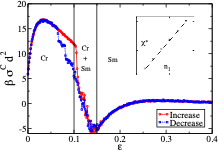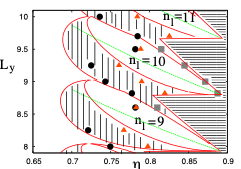[Home] [Research] [People] [Teaching] [Collaborators]
confined system
-
•Mechanical response and phase behavior of confined solid
We showed that a system of few payers of atoms in two dimensions, when confined laterally by a pair of parallel hard walls within a quasi one dimensional channel, possesses several anomalous structural and mechanical properties not observed in the bulk. Depending on the density and the distance between the walls, the system shows structural characteristics analogous to a weakly modulated liquid, a strongly modulated smectic, a triangular solid or a buckled phase. At fixed density, a change in the channel width leads to many reentrant discontinuous transitions involving changes in the number of layers parallel to the confining walls. This depends on the commensurability of inter-layer spacing with the channel width.The solid shows resistance to elongation but not to shear. When strained (elongated) beyond the elastic limit it fails undergoing plastic deformation but surprisingly, as the strain is reversed, the material recovers completely and returns to its
in the bulk. Depending on the density and the distance between the walls, the system shows structural characteristics analogous to a weakly modulated liquid, a strongly modulated smectic, a triangular solid or a buckled phase. At fixed density, a change in the channel width leads to many reentrant discontinuous transitions involving changes in the number of layers parallel to the confining walls. This depends on the commensurability of inter-layer spacing with the channel width.The solid shows resistance to elongation but not to shear. When strained (elongated) beyond the elastic limit it fails undergoing plastic deformation but surprisingly, as the strain is reversed, the material recovers completely and returns to its  original undeformed state. We obtained the phase diagram from mean field theory and finite size simulations. Further, the relative fluctuations of displacement field in the direction parallel to the walls, crosses over from a two dimension like logarithmic divergence to an one dimension like linear divergence. The cross over length grows with the channel width approximately linearly. The results were published in Phys. Rev. Lett. 93, 115702 (2004) , and J. Chem. Phys. 128, 194702 (2008).
original undeformed state. We obtained the phase diagram from mean field theory and finite size simulations. Further, the relative fluctuations of displacement field in the direction parallel to the walls, crosses over from a two dimension like logarithmic divergence to an one dimension like linear divergence. The cross over length grows with the channel width approximately linearly. The results were published in Phys. Rev. Lett. 93, 115702 (2004) , and J. Chem. Phys. 128, 194702 (2008).


-
•Heat conduction in confined solid strips:
We studied heat conduction in the same system while undergoing external strain, through non-equilibrium molecular dynamics simulations. The strain leads to deformation and failure of the solid and we found that the transformation in internal structure can lead to very sharp changes in the heat current [Phys. Rev. E 74, 016114 (2006)]. We found similar features for electrical conduction as well [Europhys. Lett. 73, 765 (2006)]. Since the strain dependent transition is reversible, this may be used to design mechanically controlled nano-switches.
